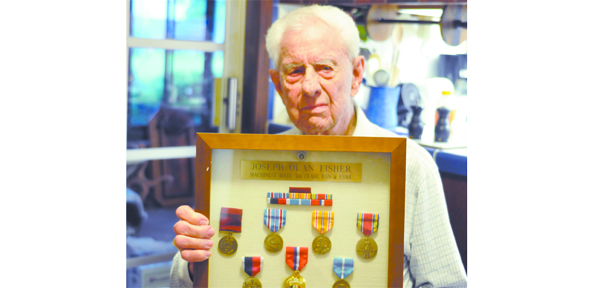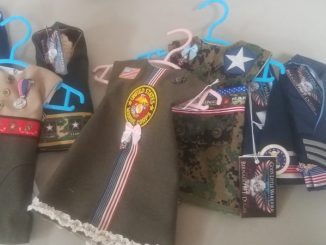
Joseph O. Fisher was finally on his way to following his brother into the U.S. Navy, but little did he know it would take him through two wars, two atomic bombs and the aftermath of Pearl Harbor.
Fisher was 17 years old.
Seventy-three years later at his Luling residence, Fisher displayed a box of several medals chronicling his seven years of wartime service: U.S. Navy, American Campaign, Asiatic Pacific, World War II, Liberty, Korea and Occupation of Leyte’ and Japan.
It’s a fitting remembrance considering his family’s military history and for a 90-year-old man who still vividly recalls his experiences in the military.
“It seems like every generation was in a war,” he said.His father served in the U.S. Army’s border patrol pursuing Mexican revolutionary leader Poncho Villa and then he later served in France and Germany. His father-in-law was an officer in the Army in World War I. He and his brother joined the Navy and served in World War II. His father’s second cousin was a lieutenant general in the U.S. Army in World War I.
Fisher was assigned to an amphibious ship, but was quickly transferred as a machinist to another unit.
By 1944, he was stationed at the military base in Pearl Harbor, Hawaii, where he saw the sunken remains of battle ships in the harbor from Dec. 7, 1941 Japanese attack that brought the U.S. into World War II.
“When we got there, there were still a lot of signs of the attack,” Fisher said. “The ships that sunk were still visible. I was an 18-year-old … I was just big-eyed. I didn’t realize what we were getting into. I was just one of a bunch.”
Fisher and his boot camp buddies, all from Texas, were quickly noticed by their chief petty officer from California who had just dealt with another bunch of Texans, said Fisher, a native of Marshall, Texas.
On arrival, Fisher said the chief commented, “Oh, damn, another bunch of Texans.”
Fisher, stationed in the advanced personnel base, recalled watching the many ships coming and going in the ship channel to Pearl Harbor.
“We swam in the channel until we found out there was barracuda there,” he said. “But we found out they weren’t hungry because that’s where the ships dumped their garbage and they had plenty to eat.”
From there, Fisher’s buddies went on submarine service, but his own orders took him to the Battle of Leyte’, part of the Philippines invasion of 1944-45 in the Pacific campaign of World War II. His unit ended up on Guam in 1945 waiting to invade an island south of the main Japanese islands and witnessed a kamikaze suicide bomber.
“This was the first time we had seen them deployed against American warships,” he said. “While on Leyte’, there was another maintenance unit about five miles south of us on the island and we in the northern area, when a kamikaze plane crashed into munitions.
“That night, as the munitions exploded, we spent the night in foxholes. When we awoke the next morning, the surrounding sandbags were pocked with shrapnel. We survived, but I wasn’t as hopeful for the other naval unit.”
Gratefully, he recalled how his unit did not end up in the invasion of Japan itself.
Instead, the U.S. dropped the two atomic bombs on Japan in August of 1945, a move that Fisher estimated saved several million U.S. and allied lives, including his own.When soldiers from the North Korean People’s Army poured across the 38th parallel, the Korean War started on June 25, 1950.
By then, Fisher was pursuing his engineering degree at Louisiana State University, but he was called to active duty by the Naval reserve to do his part in the war, too.He was assigned to an ammunition ship he boarded in Sasebo, Japan, headed for the Battle of Inchon, Korea, an amphibious invasion that resulted in the decisive victory and reversal in favor of the United Nations.
It was a time when he saw something new – a Landing Craft Infantry. The assault vessel was designed to transport troops in amphibious warfare.
“At sea, it looked like a submarine, but it would bounce one way then the other,” he said.
And just when Fisher thought he’d seen it all – he saw rockets for the first time, too.
But what he best recalled about the battle was, “Thank God for complete air supremacy or I wouldn’t be here talking to you.”
From Inchon, Fisher’s ship pulled out of the South Pacific to transport lepers from the islands to a colony in Saipan, the largest island of the Northern Mariana Islands.
“It took me seven years to get my degree because I had to go into the military so much,” he said.
But by 1953, he married Caroline Frierson, earned a degree in engineering and was hired by Monsanto Subsidy Chemstrand in Pensacola, Fla.
By age 29, Fisher had moved to St. Charles Parish in 1967.“On Highway 90 on Boutte, where we lived at first, there was a cow pasture next to it – a big cow pasture,” he said.
“Harry Post ran his cattle in there for several years and now there are stores there all the way to the Hale Boggs Bridge.”
He eventually moved to Willowdale Subdivision – the fifth home built in the subdivision with nearly 200 lots and a golf course. He went to work in the training center for Monsanto and later as a safety engineer where stayed 26 years. During this time, Fisher also became a supporter and organizer of Junior Achievement in St. Charles Parish.His wife passed away in April of 1998.
Five years ago, he had to give up golf because of a hurt shoulder, but he won’t give up ballroom dancing. Every Sunday, he goes to Jefferson Orleans for ballroom dancing.“It has a full orchestra, not just bands,” Fisher said. “I like the old time music, ballroom style.”
Now, at age 90, Fisher said he often thinks back to his life as a youth.
“When I was a little child, it was during the Depression,” he said. “A lot of people were starving in bread lines. My father got sick and my grandparents took me. They had a farm so we always ate well. I guess if there had been any other way, I’d been just as bad off as all those other folks.”His first real job was at an ice cream parlor.
“I enjoyed that ice cream,” Fisher said. “I got paid 50 cents an hour and all the ice cream I could eat.”He was fired from that job. The reason – he ate too much ice cream.
But he held many other jobs during this time that included bagging groceries, selling fireworks, and selling watermelons and cantaloupe (two for a nickel).
“I was a real entrepreneur,” Fisher said. “We went everywhere barefooted and I had a new pair of sneakers each fall for school, but we didn’t consider ourselves poor. We just didn’t have money. We had food to eat and a place to sleep.”
And, now all these years later, he has bound these many experiences into his secret of long life.
“I attribute it to being raised on a farm, always living a clean life and having a loving family that now includes three great-grandchildren,” Fisher said. “I also go to church regularly and I do believe that’s an important part of everybody’s life – that’s my combination.”




Be the first to comment